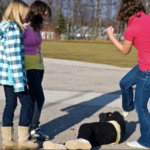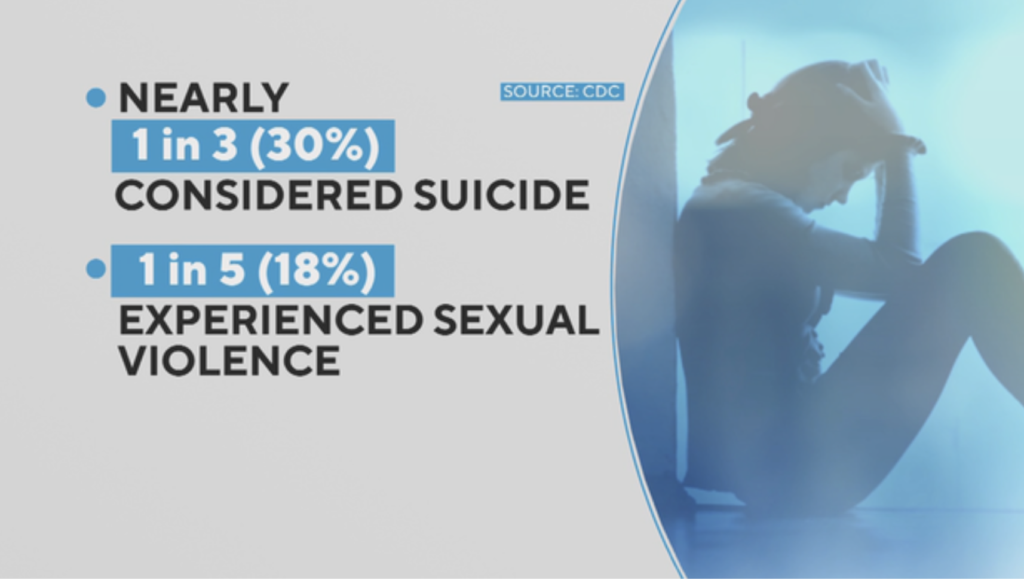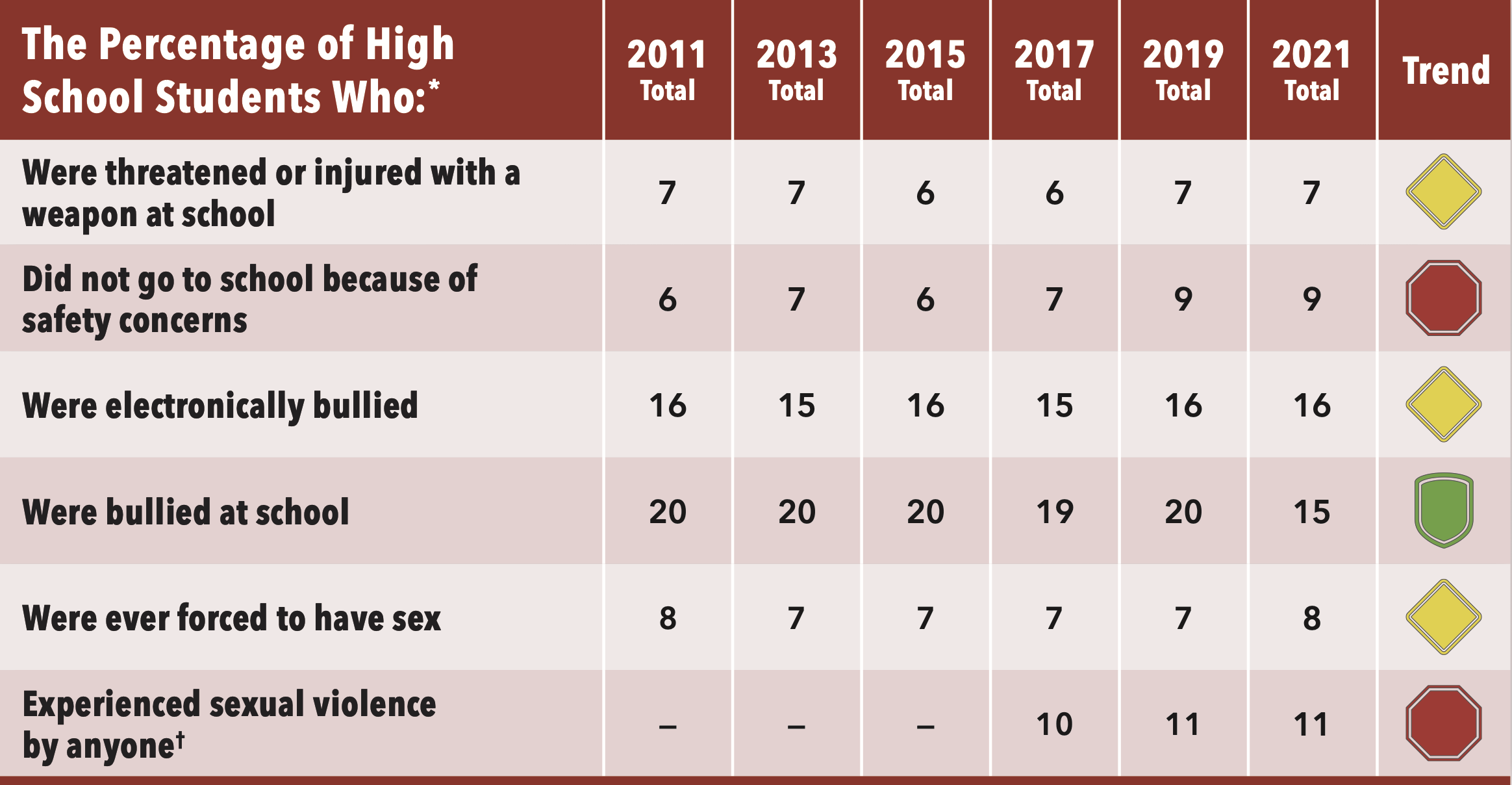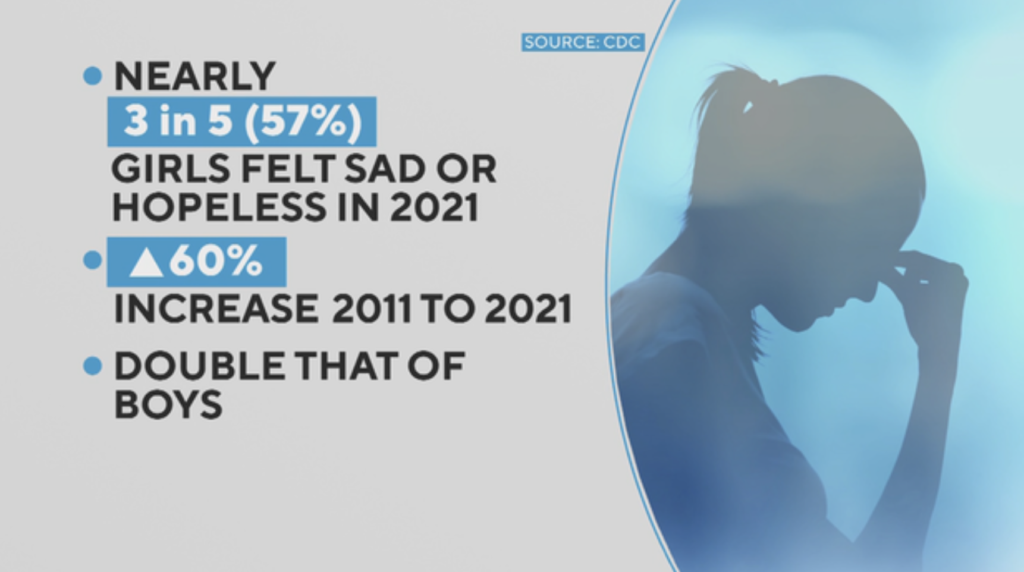
by James C. Sherlock
The 2021 Youth Risk Behavior Survey (YRBS) Data Summary & Trends Report: 2011–2021 , was released by the CDC on Monday, provides the most recent surveillance data, as well as 10-year trends, on health behaviors and experiences related to adolescent health and well-being among high school students in the United States.
The survey was completed in the Spring of 2021.
The report writes that teen girls are “engulfed in a growing wave of violence and trauma.”

This survey is brought to you by CDC, the national sponsors of school shutdowns. Who could have imagined?
The survey did not include middle- and grade-school students, but we can assess that such conditions did not spring up full grown in the 9th grade.
Where, exactly, are the feminists? Especially the ed-school feminists? Like Positive Behavioral Interventions and Supports (PBIS) cheerleader Professor Catherine Bradshaw at the UVa School of Education and Human Development.
PBIS in place in most schools in Virginia and across the nation in that same 10-year period by design keeps violent and dangerous students in schools.
It is what PBIS is supposed to do. So those students can be socialized.
Or not.
That survey should, but will not, put to rest progressive insistence that out-of-control violence among students and fear in American schools because of violence are figments of conservative imaginations.
It confirms that increasing absenteeism is linked to fear. Which progressives will also continue to deny.
Teachers are trying to teach in an environment that is wracked with violence and fear among female students especially. Also denied.
And that those progressive prescriptions for interventions and supports are not having the intended results.
That part of the assessment progressives will jump on.
Led by schools of education they will respond, as they must to honor dogma, that the permissive discipline systems they designed are underfunded, badly implemented, or both, requiring only a lot more money and teacher training (expensively provided by the ed-schools) to achieve the intended results.
While the Virginia mental health system tries to gear up to help the victims.
Experiencing violence. Below are the overall trends in the “experiencing violence” category in the report not sorted by sex, race or ethnicity.

We learn from the report that girls’ exposure to violence increased, their rates of sadness and hopelessness soared 60% to reach nearly three in five, and that 30% of them considered suicide.
Female students, LGBQ+ students, and students who had any same-sex partners were far more likely than their peers to experience violence.
Their exposure to sexual violence is unacceptable.
Girls and white students threatened or injured with a weapon at school increased; minority percentages decreased.
In the period 2011 to 2021, the boys answering that survey metric as yes dropped from 10% to 7% while the girls increased from 5% to 6%.
The pacing decrease was a reduction in this metric among minority students, especially students of Asian descent that dropped from 7% to 3%.
The percentage of white students threatened or injured with a weapon at school increased from 6% to 7 % over that same timeframe.
Threats and injuries with a weapon on those sexually active or sexually active with same sex partners.
Among students who had sexual contacts, threats and injuries with a weapon at school increased to 9% who had relations with the opposite sex and 15% of those who did so with same sex partners.
Sexual violence was at shocking levels.
The survey found that in 2021:
- Nearly 20% of female students experienced sexual violence by someone, and nearly 15% had been forced to have sex;
- The percentage of female students who experienced sexual violence increased from 2017 to 2021.
Safety concerns and absenteeism related to safety concerns soared.
Between 2011 and 2021, the percentage of high school girls who did not go to school during the past 30 days because of safety concerns nearly doubled from 6% to 10%.
Absenteeism due to fear among all students increased 50%.
The number of Black students who did not go to school for the same reason soared between 2011 and 2021 from 7% to 12%. Hispanic students were just behind at 11%.
Eighteen percent of those who had sexual contacts with the same sex skipped school because of fear for their safety.
Bullying declined.
Twenty percent of girls were electronically bullied in the past year. But that was actually down from 22% in 2011. Black students were by far the least electronically bullied at 10%;
The percentage of high school students who were bullied at school during the past year declined over the previous decade in both boys and girls. Black students are the least bullied at school among any group.
School family life instruction. Code of Virginia § 22.1-207.1. Family life education includes requirements to teach abstinence and the value of postponing sexual activity.
It is also requires schools to teach about dating violence, the characteristics of abusive relationships, steps to take to deter sexual assault, the availability of counseling and legal resources, and, in the event of such sexual assault, the importance of immediate medical attention and advice, as well as the requirements of the law.
Finally,
All such instruction shall be designed to promote parental involvement, foster positive self-concepts, and provide mechanisms for coping with peer pressure and the stresses of modern living according to the students’ developmental stages and abilities.
However family life is taught, it clearly has not worked to the degree intended.
Perhaps including in those courses the results of the latest CDC survey will help students consider such instruction more important and pragmatic.
Perhaps they can inform them that same sex sex is especially dangerous.
School discipline systems. School discipline systems did not prevent that wave of violence and fear in the schools. Positive interventions and supports did not mitigate violence and fear as they were intended to do.
Indeed, Virginia schools continue, encouraged by Virginia law and the policies of many of our school divisions, to harbor “students who have already engaged in disruptive or violent behavior” as recommended in 2006 by the American Psychology Association.
Principals are told not to suspend from school, expel, or report to law enforcement any but those who commit criminal felonies in school. Assault and battery, petty larceny and some drug crimes are misdemeanors in Virginia.
“Students who have already engaged in disruptive or violent behavior” is the very definition of Tier 3 students retained in schools under PBIS. Retaining them in school is somehow considered a feature not a bug.
One of the most illustrative government statistics you will ever see about the effects of PBIS is in the opposite directions in trends of school violence between what was reported to police (down) and what actually was happening in the schools (up) in 2017-18.
This from Indicators of School Crime and Safety: 2019
The percentages of public schools that recorded one or more incidents of violence, theft, or other crimes and that reported such incidents to the police were lower in 2017–18 than in every survey year between 1999–2000 and 2009–10. (emphasis added)
However, the percentage of schools that recorded serious violent incidents was higher in 2017–18 than in 2015–16 (21 vs. 15 percent). (emphasis added)
Again, PBIS supporters consider that a success.
Bottom line. The CDC report is profoundly disturbing.
It provides data to quantify many of the academic, behavioral and mental health problems that those schools face.
PBIS over that decade not only did not help, but indeed violence and fear in schools have actually increased on its watch. That cannot be surprising because PBIS was designed to keep violent and dangerous students in school in the hope that they could be helped.
Finally, on the basis of the CDC findings, the numbers of students, especially girls, with diagnosed emotional disabilities and individualized educational programs (IEPs) for special education and treatments for those disabilities may be far lower than the actual need.
For which, as we have discussed before, there are not enough child and adolescent mental health professionals in Virginia to address the need.
Unless these trends towards violence and emotional despair affecting and driving away students and teachers are reversed, the public schools are finished, and soon, as a core feature of American society.
Many far-left progressives would rather see the public schools die than be reformed in ways of which they disapprove, such as by charter schools, by the repeal of race-based discipline quotas, and by the banishment from schools of violent and dangerous students.
That lot, thickest in our state-funded schools of education and their doctoral graduates in the public schools, is more dangerous than the in-school criminals themselves.
And it includes a lot of women who claim, against all evidence, to be feminists.
Updated Feb. 16 at 12:15 to further parse and clarify data and add graphics.


Leave a Reply
You must be logged in to post a comment.